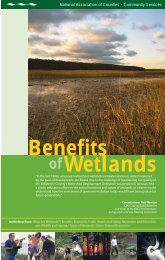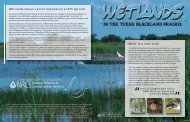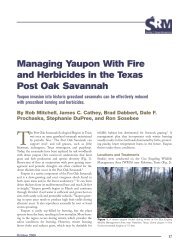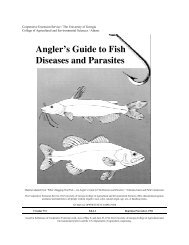Texas Farm Ponds: Stocking, Assessment, and Management ...
Texas Farm Ponds: Stocking, Assessment, and Management ...
Texas Farm Ponds: Stocking, Assessment, and Management ...
You also want an ePaper? Increase the reach of your titles
YUMPU automatically turns print PDFs into web optimized ePapers that Google loves.
Table 1. Recommended Numbers of Fingerlings to Stock for Various <strong>Management</strong> Options in <strong>Texas</strong> <strong>Farm</strong> <strong>Ponds</strong>.<br />
Number per Surface Acre to Stock<br />
Pond Size<br />
Fish Species<br />
Un-Fed Fed 1<br />
Fertilized<br />
Unfertilized<br />
Any Size<br />
Channel Catfish<br />
or Blue Catfish<br />
Up to 300 + 3 pounds<br />
fathead minnows<br />
Up to 150 + 3 pounds<br />
fathead minnows<br />
Up to 1000 3<br />
More than One Acre<br />
Largemouth Bass<br />
100<br />
Bluegill<br />
Fathead Minnows<br />
Channel Catfish 2<br />
Largemouth Bass<br />
Bluegill<br />
<strong>and</strong><br />
Redear Sunfish<br />
Fathead Minnows<br />
Channel Catfish 2<br />
1 Do not fertilize catfish ponds where catfish are being fed.<br />
2 May be stocked to increase fishing opportunities.<br />
3 Above 700 fish, harvest is m<strong>and</strong>atory at 2 to 3 pounds;<br />
1,000<br />
10 pounds<br />
100<br />
100<br />
750<br />
<strong>and</strong><br />
250<br />
10 pounds<br />
100<br />
50<br />
500<br />
5 pounds<br />
50<br />
50<br />
375<br />
<strong>and</strong><br />
125<br />
5 pounds<br />
50<br />
After 3 years, you need to make a decision about<br />
the kind of bass fishing you want to promote for<br />
your pond. Bass will have reproduced two or three<br />
times during this 3-year period, <strong>and</strong> the pond may<br />
have large numbers of young bass. If the young bass<br />
are under-harvested, they will have to compete for<br />
the available food <strong>and</strong> their growth rates will be<br />
poor. The result will be a bass population consisting<br />
mainly of fish less than 12 inches long. All these<br />
small bass will reduce the number of small bluegill,<br />
<strong>and</strong> the pond will have a surplus of 7- to 8-inch<br />
bluegill.<br />
If you are interested in catching bass larger than<br />
12 inches long, 8- to 12-inch bass must be harvested.<br />
Harvest about twenty-five 8- to 12-inch bass<br />
(weighing a total of 10 to 15 pounds) per acre each<br />
year after the third year from stocking. Removing<br />
these small bass reduces competition <strong>and</strong> allows<br />
some fish to grow to larger sizes. Other factors that<br />
affect largemouth bass growth rate include genetics,<br />
water quality, habitat, <strong>and</strong> prey availability.<br />
Average growth for bass in <strong>Texas</strong> are:<br />
Age I 8 inches<br />
Age II 12 inches<br />
Age III 15 inches<br />
Age IV 17 inches<br />
Age V 18 inches<br />
Lengths above represent averages for both sexes<br />
combined, <strong>and</strong> can vary considerably among pond<br />
bass populations <strong>and</strong> fish gender. It is worth noting<br />
that a properly managed bass population with<br />
adequate prey supply should exhibit faster growth<br />
rates than those previously described. Table 2<br />
shows average weights for bass of various lengths.<br />
These statistics are useful for estimating the total<br />
poundage removed per surface acre per year.<br />
Table 2. Average weight for largemouth bass<br />
of various lengths.<br />
Largemouth Bass<br />
Length (inches)<br />
Average Weight<br />
(pounds)<br />
8 0.25<br />
9 0.35<br />
10 0.50<br />
11 0.70<br />
12 0.90<br />
13 1.10<br />
14 1.50<br />
15 1.80<br />
16 2.25<br />
17 2.70<br />
18 3.30<br />
19 3.90<br />
20 4.50<br />
21 5.40<br />
To keep bluegill in good condition, incorporate a<br />
“slot limit” for releasing 12- to 15-inch bass after the<br />
third year. Releasing bass of this size will also<br />
ensure that some bass will grow to more than 15<br />
inches. Keep the harvest of bass longer than 15<br />
inches to a minimum so that some larger, quality<br />
bass will survive.<br />
15









